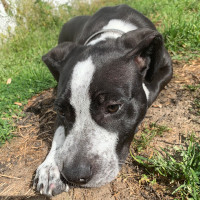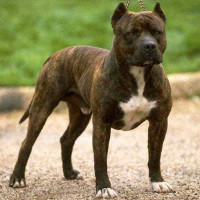Appearance of the Pit Heeler
|
| Pit Heelers are the result of crossing American Pit Bull Terriers and Australian Cattle Dogs. American Pit Bull Terriers have thick, muscular necks that hold broad, brick-shaped heads between the cheeks. The jaws are very powerful and meet in a scissor bite, and the chests are deep and broad. Overall, these dogs appear muscular and stocky, although they are quite athletic and very strong too. Their tails taper and thin as they approach the end. The ears are sometimes cropped, but the tails are never clipped. American Pit Bull Terriers have round eyes. Australian Pit Bull Terriers are compact and robust, with an agile, well-muscled body that is a little longer than it is tall. The slightly curved tails are kept moderately low and the front legs, which end in round feet with short toes, are strong and straight. These dogs also have a broad head with a slight curve between the ears and a well-defined stop. The broad ears are medium-sized and become erect when the dog is alert. Australian Cattle Dogs have medium-sized eyes that are dark and oval-shaped. This breed has similar teeth to the other parent, as they also meet in a scissor bite. Your Pit Heeler will be strong and agile, with a well-muscled build. His eyes will have an air of confidence and knowledge. |
Temperament of the Pit Heeler
|
| These dogs make excellent pets as long as they are well trained in their youth. This hybrid gets its excellent companion trait from the Australian Cattle Dog parent, and both parents are generally quite obedient and easy to train as they respond well and like to please their owners. However, they are always best suited to owners who have already owned dogs. The parents have high or moderate hunting instincts, which means the Pit Heeler needs to be watched around small pets. They are generally not noisy dogs, as both parents rarely or occasionally bark. Australian Cattle Dogs can sometimes be aggressive and protective, although they are also intelligent, loyal and alert. American Pit Bull Terriers are more affectionate, social and friendly, with happy, cheerful personalities. Bear in mind that the Pit Heeler can adopt any of these traits. It's important that all dogs, whatever their breed, are properly socialized when they're young. This will ensure that, as adults, they will be ready to face any situation and be able to cope with all kinds of people and animals they may encounter. |
Needs and activities of the Pit Heeler
|
| These dogs are very energetic and will need plenty of daily exercise to stay fit and happy. The Pit Heeler gets these high activity needs from both parent breeds. These creative dogs will enjoy a variety of activities, including hiking, swimming, running or jogging, retrieving, agility, obedience and other dog sports. Given the needs of the parents, we can assume that the Pit Heeler will need around 45 to 60 minutes of activity per day. Dogs also need to be exercised and challenged mentally and physically, especially breeds like the Pit Heeler that are highly intelligent. |
Maintenance of the Pit Heeler
|
| To determine how you should care for your pet, consider the maintenance needs of parent dogs. The Pit Heeler's coat should be brushed about once a week, and the Pit Heeler should be bathed as needed. They will need to have their nails trimmed regularly, which will probably be every one to two months. Some may notice that their dog needs their nails trimmed more or less often, which would be normal as the more active or less active your dog is, the faster or slower the nails will wear. All dogs will benefit from weekly ear cleaning, as this will reduce the risk of developing ear infections. At least two or three times a week, you should brush your dog's teeth. This will keep gums and teeth healthy and in good condition. The best frequency for brushing your dog's teeth is every day. |









 English (United Kingdom)
English (United Kingdom)